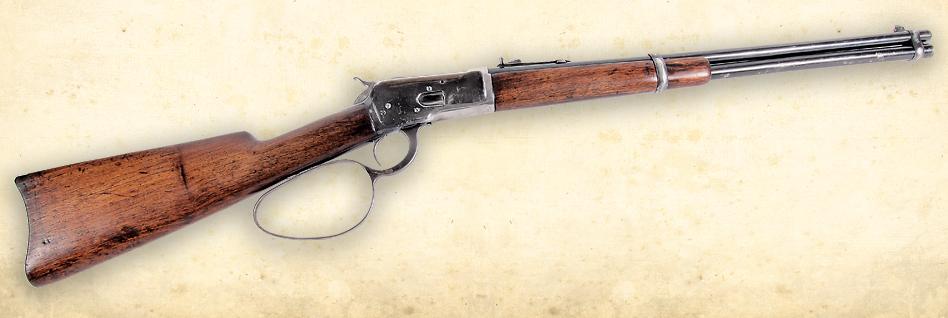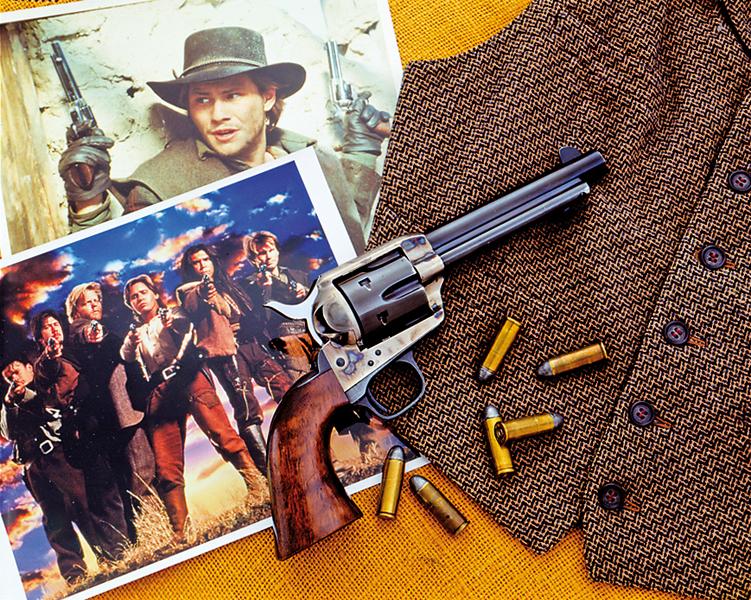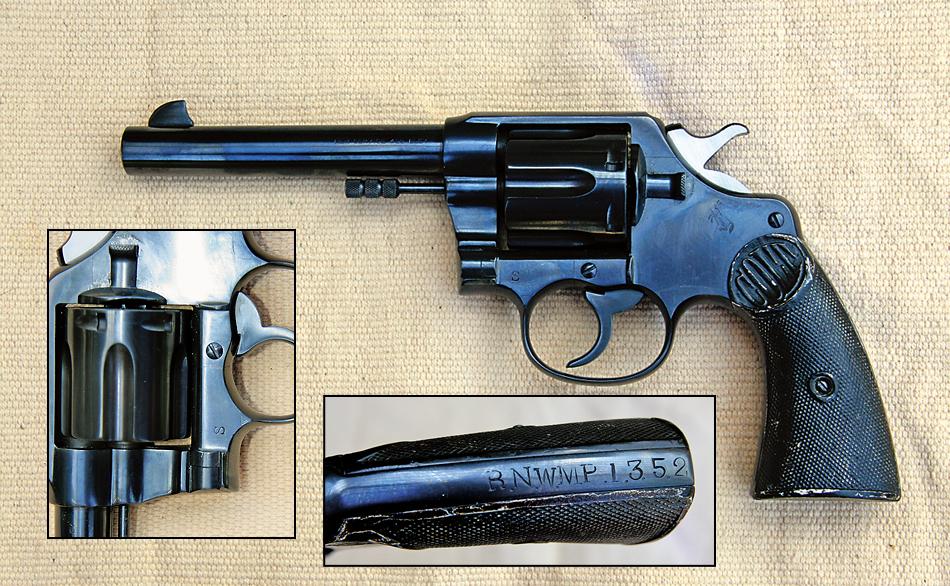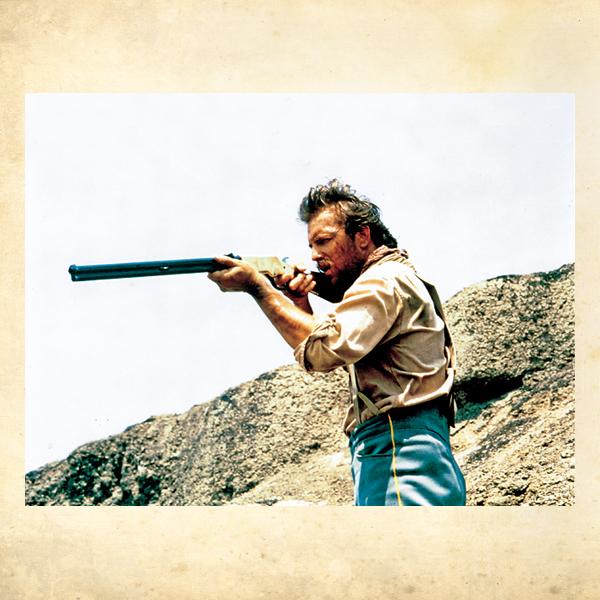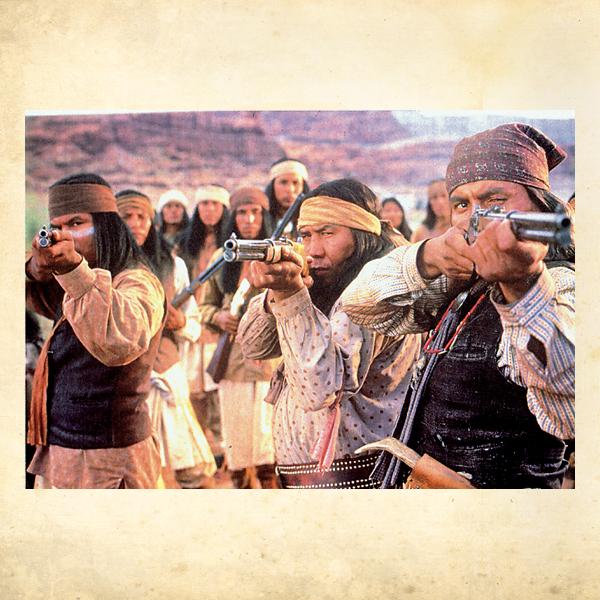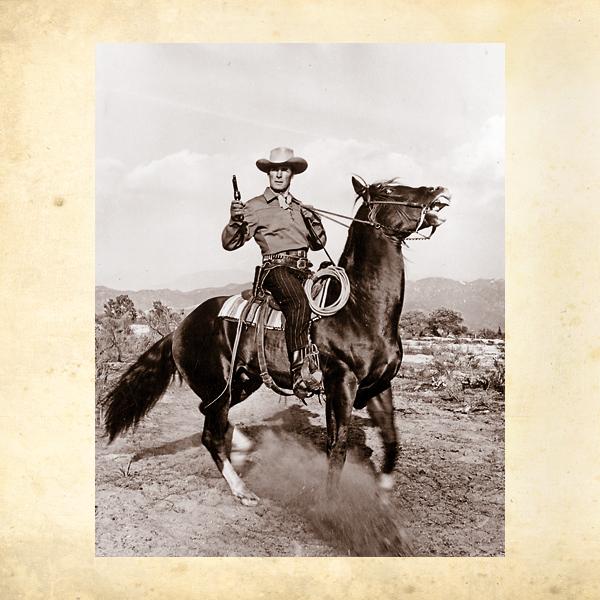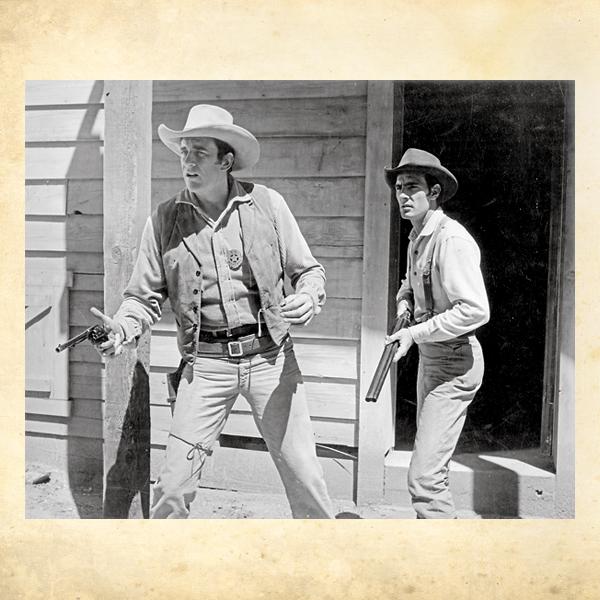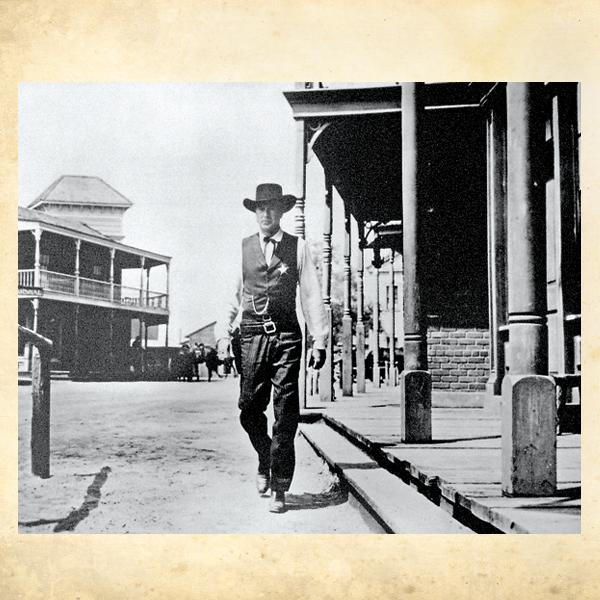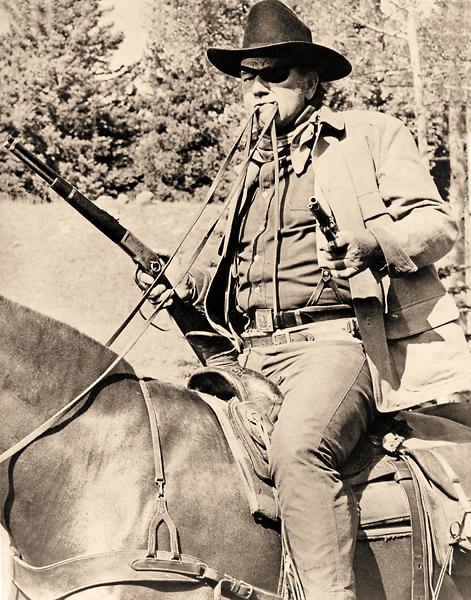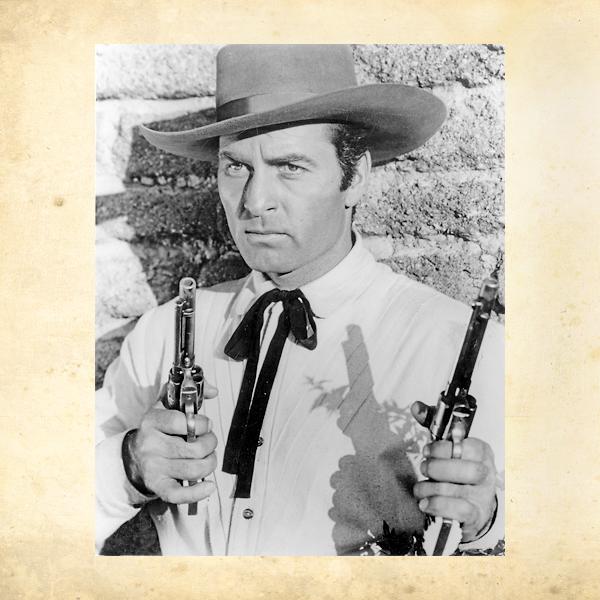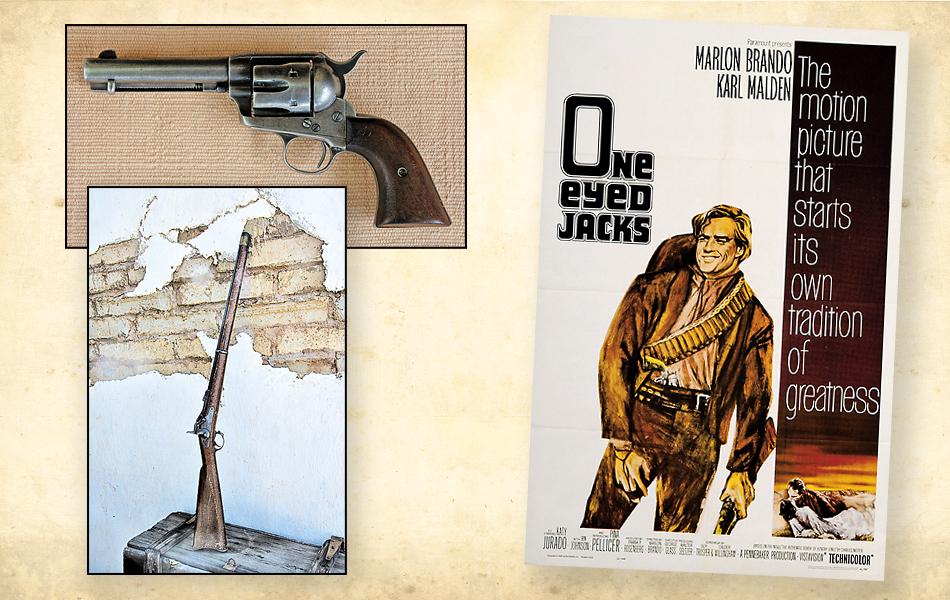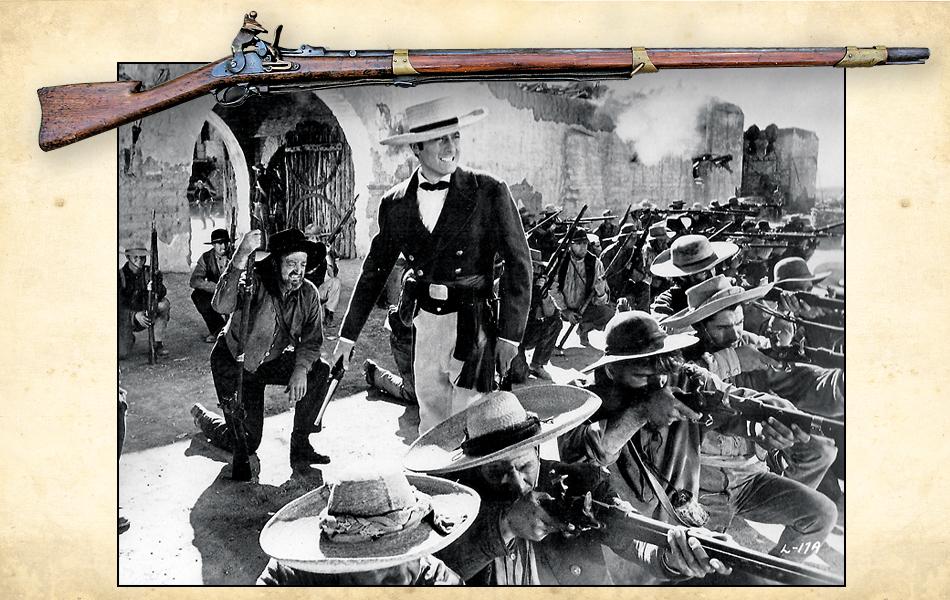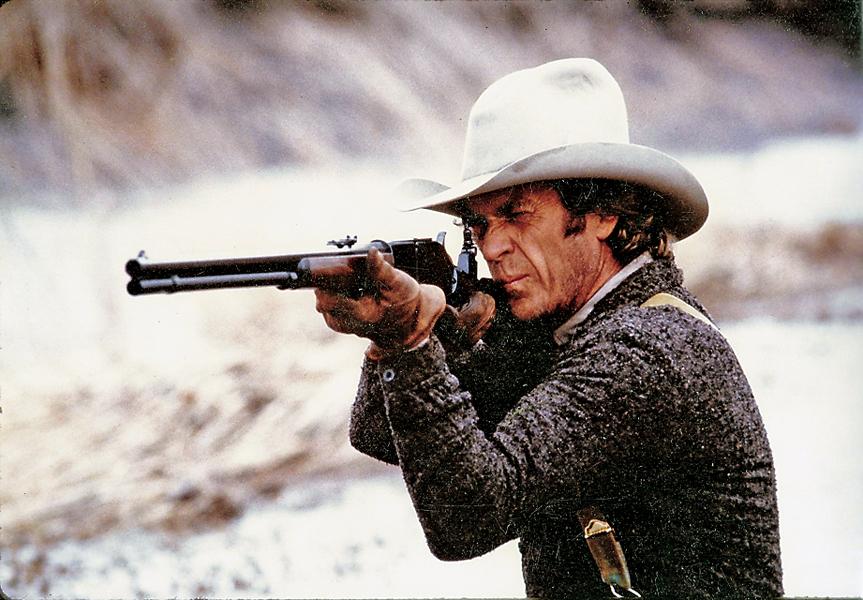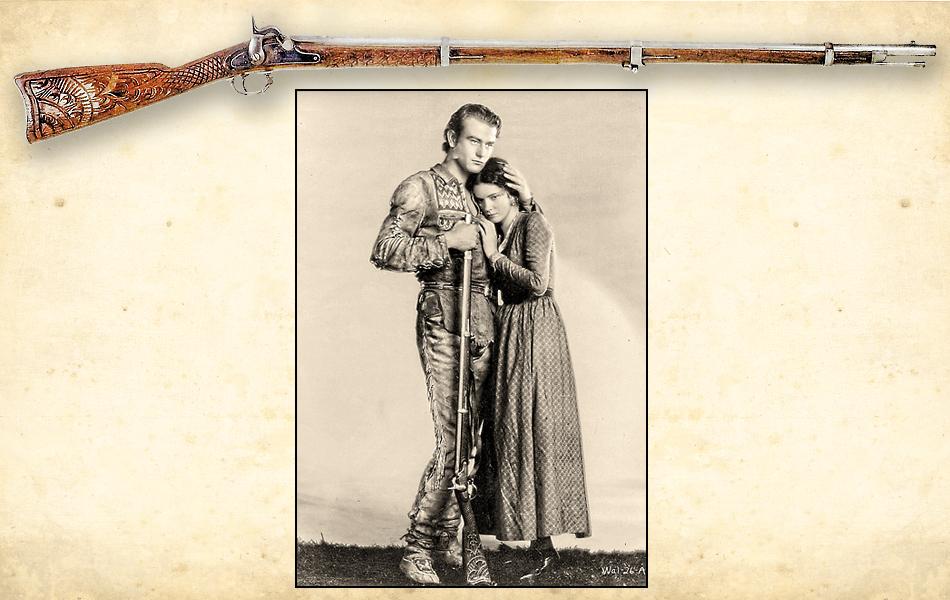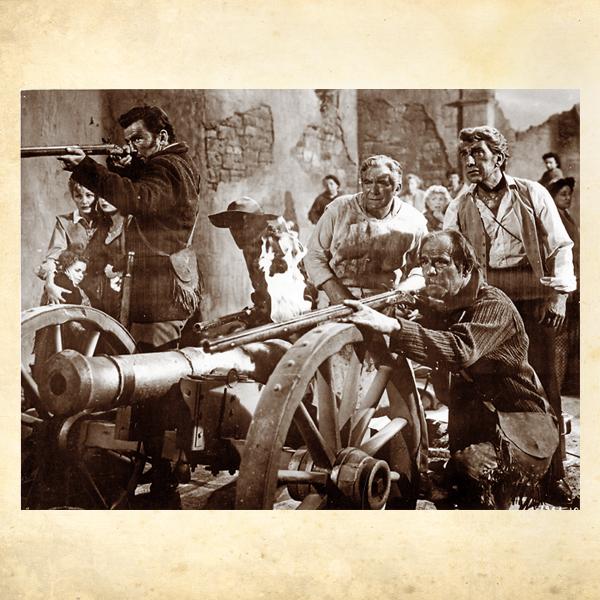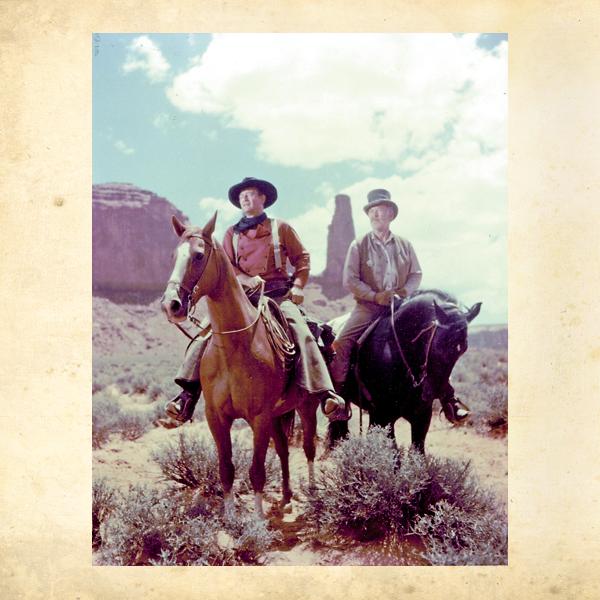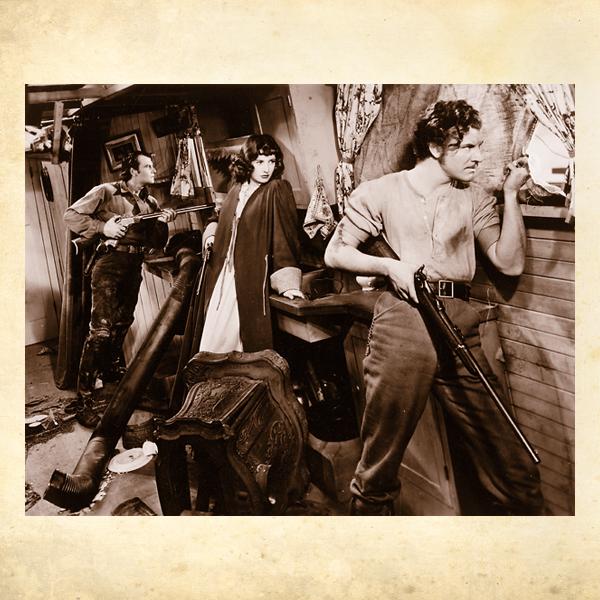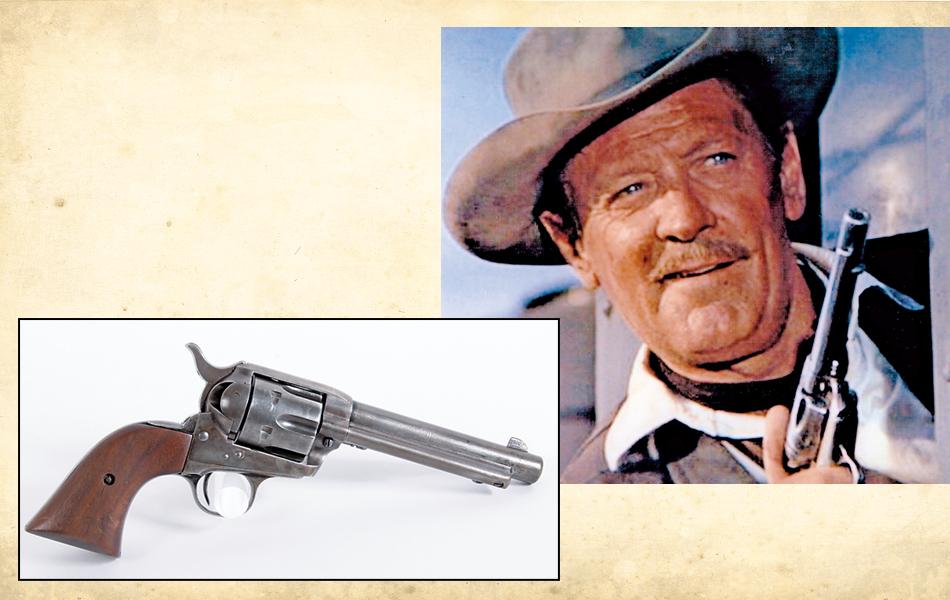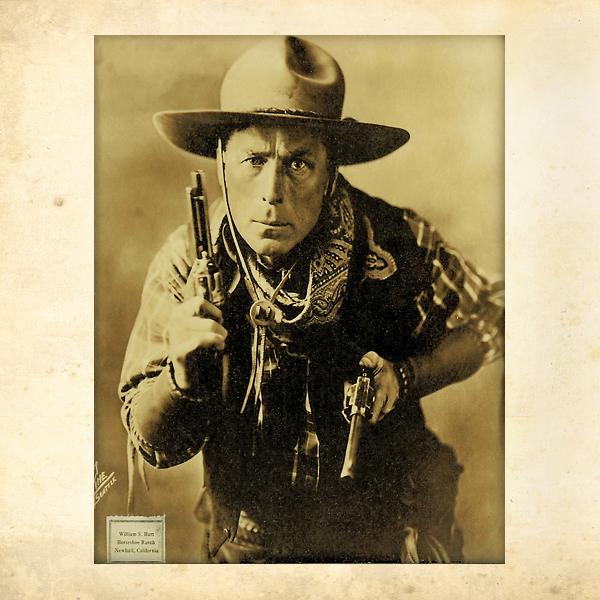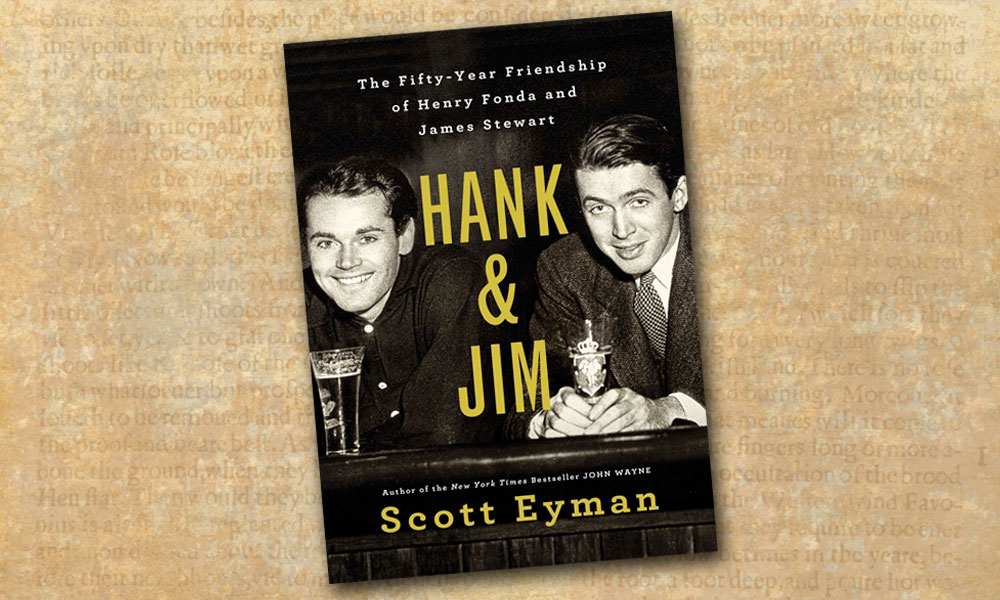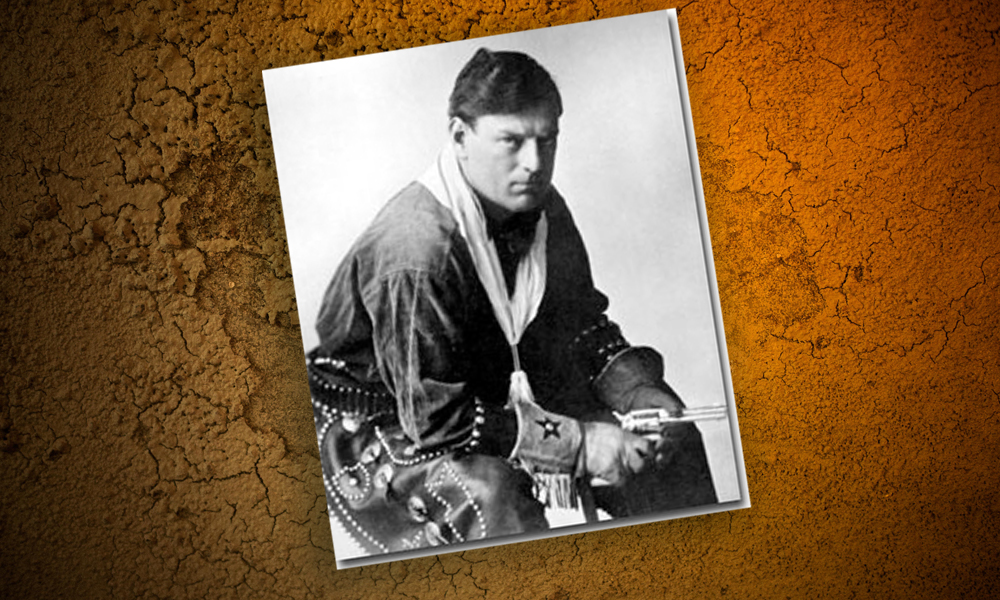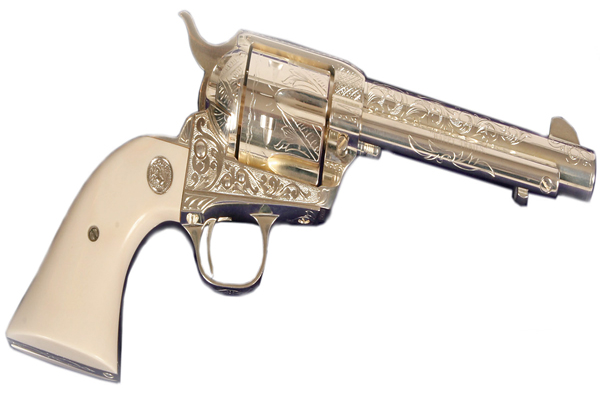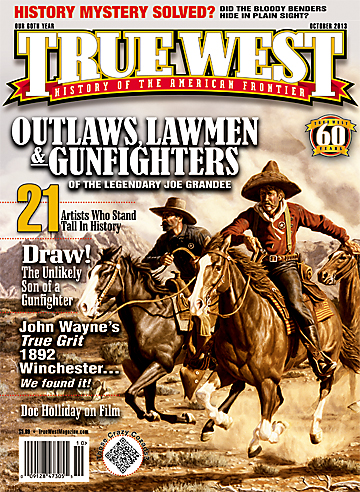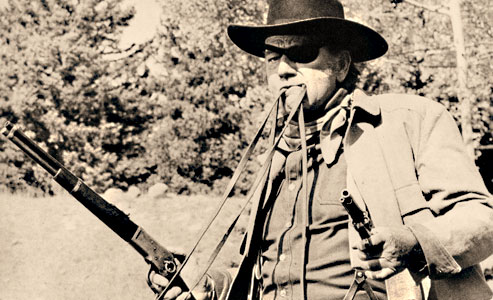 Have you ever wanted to own a gun used in a Western film by one of your favorite cowboy stars…or even one packed by one of the supporting actors in an Oater that you held in special esteem?
Have you ever wanted to own a gun used in a Western film by one of your favorite cowboy stars…or even one packed by one of the supporting actors in an Oater that you held in special esteem?
Up until a few years ago, that feat was next to impossible for the average firearms enthusiast.
But with the closing of a number of the firearms rental houses and major sell offs of props and costuming by several of the studios, quite a number of motion picture guns, considered little more than props by much of the film industry, are becoming available to motion picture buffs. While still not on the market in great numbers, as might be the case with other collectible firearms, movie and TV prop guns can occasionally be found, sometimes resting amongst a collection of “for sale or trade” shooting irons on a table at a gun show or a collector’s meeting…if you can identify the telling signs that point to them being moving picture guns.
Just Props!
A firearms searcher on the prowl for a movie or TV firearm should first look for a gun with little or no finish, a refinished arm perhaps, or maybe one with a chopped barrel or some other alteration performed that would otherwise be considered sacrilege to the serious arms collector. Filmmakers sometimes had guns refinished to give them a new look, or altered in some other way—especially if the guns were to be featured as an integral part of the story. Since most Western movies are period films depicting the West of the mid-to-late 19th century, or at the latest, the early 1900s, the firearms used in those shoot-’em-ups are likely to be well used and somewhat abused. In other words, don’t look for mint condition arms. Movie guns often get rough handling in the making of a Western!
Some examples of refinished or “customized” cinema guns would be the Smith & Wesson Schofield revolvers used by the “Schofield Kid” in Clint Eastwood’s 1992 Academy Award-winning film Unforgiven. I had the good fortune to supply the gunleather for the actors in that flick, except for Eastwood, who had at first planned on carrying his Starr double-action revolver in his waistband, before he later decided to have a holster made—probably while on location. Incidentally, arms accessories such as gunleather, knives and other props also make for interesting collectibles and sometimes turn up in unexpected places, but that’s the subject of another story.
While visiting Hollywood’s Ellis Mercantile, the prop house where I dropped off the gunleather for the movie, I saw that the prop people had purchased four original 1875 Schofields for use by the “Schofield Kid” in Unforgiven and had them completely refinished to look like new guns. This was just a couple of years before Navy Arms produced its first replicas of that frontier Smith & Wesson, so original examples were sought out.
In 1980’s Tom Horn, starring Steve McQueen, three vintage 1876 Winchester rifles were reblued specifically for that photoplay. For John Wayne’s 1971 horse opera Big Jake, Hollywood’s Stembridge Gun Rentals cobbled up a Walther P-38 with some ersatz parts to give it the rough appearance of an early 1900s Bergmann auto pistol, as used by Christopher Mitchum. Some older collectors may recall that in the 1950’s classic James Stewart Western Winchester ’73, the studios had a trio of 1873 Winchesters sent back to the New Haven firm for refinishing and engraving to look like the famed “One of One Thousand” rifles; Winchester ran a huge ad campaign looking for “One of One Thousand” ’73s at the time (see my coverage of one of these Winchesters in the June 2006 issue of True West).
Surviving records reveal that, throughout the TV Western craze of the 1950s-60s, Stembridge Gun Rentals, who supplied a majority of the TV shoot-’em-ups firearms, reblued a number of 7½-inch barreled Colt Single Action Army revolvers for TV series that included Gunsmoke and Have Gun Will Travel. The firm also reblued a few original 1860 cartridge conversion Colts, as well as altered some 1873 Single Action Army parts for ease of handing, for actor Nick Adams’s TV series The Rebel.
Additionally, since so many of TV’s cowboy stars used short-barreled Peacemakers, the various prop houses chopped a goodly number of 7½-inch barreled Colts to 5½-inch or 4¾-inch tubes.
For decades, Westerns featured so many 1892 Winchesters that many were refinished time and again. Sometimes they were recolored so often that the original serial numbers had worn off from repeated buffing, so some rental houses restamped those arms with their own serial numbers!
Bear in mind that the studios were not gun collectors, rather they were in the business of making a profit from their pictures, so these guns were simply props to be used in service of the story. In spite of these firearms being repeatedly dropped, thrown into rivers and lakes, perhaps even burned up or otherwise abused, for the most part, these films undoubtedly produced more revenue for the production companies than the value many of these arms would ever garner—especially 50 or more years ago when guns were not nearly as valuable as they are today—despite any gun enthusiast’s regards for their historic or cinematic value!
Another factor was that during the heyday of Hollywood in the 1940s and 1950s, a studio could rent a genuine Colt Single Action Army, for example, for as little as $4 per week for the first week of production, $2 for the second week, $2 for the third week and no charge for the fourth week; then the entire rate schedule would be repeated. If the gun was lost, the replacement charge was under $50! This fact is amazing to today’s gun collectors, considering that Stembridge’s surviving records reveal that the company owned several Single Action Armys in the two-, three- and four-digit serial number range, which dates them to 1873 or 1874; depending on condition, these firearms could have considerable collector value today.
Although during the classic era of movie and TV Westerns, firearms were considered nothing more than mere props, in later years, as interest in antique arms increased, several of these shooting irons did get “lost” while filmmakers were on location. In one instance, 58 Peacemaker Colts went “missing” during the making of the 1958 Walt Disney film Tonka.
A Stamp of Approval
A telltale way to identify a movie gun is the studio prop house’s distinctive I.D. stampings. Stembridge Gun Rentals, perhaps the largest firearms rental house during the so-called “Golden Years” of Hollywood, marked most (but certainly not every one) of its weapons with an “S” stamping. Although the stamp could appear almost anywhere, Single Action Colts were generally stamped over the serial number on the frame, although a great many handguns were stamped on the left side of the frame and rifles were marked in various areas. Stembridge ceased renting guns and sold off its inventory in 1999.
Ellis Mercantile, which went out of business in 2000, was another of the major prop houses that supplied arms to the movies for decades. Ellis stamped an “E” (or sometimes an “EEE”) in as many as three or more places on each Single Action Army; under the serial number on Winchester ’92s; and on the top of the barrels near the frame on other longarms like the Sharps rifles or Springfield trapdoor rifles and carbines.
MGM sold off its props, costuming and set dressings in 1970. By the mid-1980s, most of the other studios had followed suit. MGM, RKO and Republic and Monogram studios marked their guns with “MGM,” “RKO” and “R&M” respectively, while Universal Studios relied on a “UP” stamp, with the “U” over the “P”; Warner Brothers used a “WB” stamping, along with an inventory number; and 20th Century-Fox stamped the word “FOX.” Western Costume Company, which also rented out firearms as props, stamped “WCC” on its firearms.
Stembridge also purchased guns from RKO, and Ellis bought many of the Warner Brothers firearms. But since these companies marked these firearms with their own codes, these guns often featured stampings from both outfits, which would sometimes result in guns being erroneously returned to the wrong studio after a production. Rather than sending them back and going through each company’s inventory to find the missing guns, the studios considered it more economical to keep the returned arms and re-stamp them (this is a practice also followed in costuming). While not all guns were marked by the rental houses, most were.
Watch Your Western Films & TV Shows
In most cases, a gun cannot be identified merely by watching a film, but this rule has exceptions. Particular markings—such as dings in the stock, close inspection of color case hardening patterns, special sights or other significant features—can aid the collector in recognizing a particular firearm. With the availability of studio stills and the great advances made with high definition televisions and Blu-ray DVDs, viewers can now discern details on the screen that were unseen just a few years ago. Software, like Snagit by TechSmith, allows images to be pulled off in photo form which could be of value in authenticating a movie firearm. But to fully authenticate any weapon believed to have seen use in a given film or TV show, regardless of how it was visually recognized, often requires proper rental documentation.
Studio still photos helped me find a historic Western movie gun, in the early 1980s, while I was conducting research for Guns & Ammo magazine at Stembridge Gun Rentals. I located the Italian replica Colt Walker used by actress Kim Darby in the 1969 John Wayne classic True Grit. I identified it by comparing the Walkers in Stembridge’s inventory to the color lobby card of the Duke resting the huge six-gun on Darby’s shoulder and exclaiming that it was a “Colt’s Dragoon pistol.” The giveaway that it was the same firearm is the distinctive casehardened pattern on the gun’s right side. Since, like fingerprints, no two case hardening patterns are alike, I was able to recognize this famous smokewagon! Further research of Stembridge’s records revealed that this Walker replica was also used by Clint Eastwood in 1976’s The Outlaw Josey Wales. The firearm is now on display at the National Rifle Association’s National Firearms Museum in Fairfax, Virginia.
In another instance, the New Model Army 1861 Remingtons used by a young John Wayne in the buffalo hunting scene in his first feature picture, 1930’s The Big Trail, were identified by some friends of mine who freeze framed select scenes in a DVD of the film. The stop action of the freeze framing, along with the huge and extremely clear image on their big screen TV, revealed some distinctive decorative markings on the barrel of Wayne’s sidearm. These six-guns had been converted to metallic cartridge for use with motion picture blanks in order to save time in reloading cap and ball six-guns. The Remingtons, which were also packed by none other than William S. Hart for one of his early trail dust sagas, are now in private collections, and one of them is also on display at the National Firearms Museum.
Although Wayne only carries one Remington in The Big Trail, a second arm was supplied as a backup. Furnishing multiples of featured guns is standard practice in the film business in order to save production time, in the event of any malfunction of the gun. The studio supplied Duke with at least six sawed-off shotguns to represent his pair of Greeners in Big Jake. Several Colt revolvers were rented for use by James Arness during the 20-year run of TV’s Gunsmoke. Stembridge’s records show that at least 13 large loop lever 1892 Winchesters were on set for Chuck Connors to wield in The Rifleman. The use of multiple guns is actually good news for prospective collectors, since you don’t have to seek out the “one and only” firearm.
Get It On Paper
Proper paperwork with serial numbers listed is certainly the best and most ironclad proof of a gun’s usage in a given moving picture. Unfortunately, the rub for the average collector is that most paperwork, like rental sheets and other invoices from production companies, is difficult to obtain. That means many enthusiasts who own motion picture-marked guns have to be satisfied with just knowing that the gun was used in films…at least until they can somehow identify it in a production. But that’s part of the fun of movie and TV guns; you just never know when your gun will turn up in a movie or be listed on a rental invoice. I own some motion picture firearms with such easily identifying features that I am always on the lookout for them whenever a classic Western movie pops up on the tube.
East coast collector and respected motion picture firearms researcher Chris Hearn has traveled extensively, including out to Hollywood, to search surviving rental invoices and other records on movie firearms. Through years of diligent study, he has obtained copies of a number of rental documents from major rental houses. His painstaking, but as he says “enjoyable and rewarding,” time spent poring over rental house and studio records have paid off big time for this avid movie gun collector, since he has uncovered treasures that include several guns used by John Wayne in his various films, by William Holden in 1969’s The Wild Bunch and Kirk Douglas’s Colt from 1967’s War Wagon.
To give you an idea of just how such documentation can help uncover a highly desirable movie gun, Hearn was able to acquire duplicates of the Universal Studios rental sheets for the 1974 John Wayne flick Rooster Cogburn. Listed on the sheet were two large loop-levered 1892 Winchesters and a pair of Colt Single Action Armys. When Little John’s Auction Service held its June 5, 2007, auction of the Stembridge gun collection, Hearn noticed that one of the rifles and one of the Colts on his copy appeared in the auction catalogue and were listed as being “On True Grit paperwork.” When he saw that the 4¾-inch barreled Peacemaker hammered down for $81,000, he took a chance on the Winchester when it came up for bid. Since the Winchester was sold with a standard lever, a feature that threw off other bidders looking for John Wayne’s familiar large loop lever, Hearn successfully bid on the rifle for a mere fraction of the bid for the Duke’s Colt. Through his movie gun contacts, he later obtained a studio-manufactured large loop lever and replaced the standard lever on the Winchester ’92, returning the gun to its original True Grit configuration.
Hearn, who generously contributed much valuable information for this article, offers his services to folks who feel they may own a movie firearm. If you have a gun with studio or rental house markings, or you have other evidence that it may have been used in a motion picture or television production, contact Hearn at hearn20@comcast.net. Who knows, you might just discover that you own an important piece of Western movie or TV gun history!
Phil Spangenberger has written for Guns & Ammo, appears on the History Channel and other documentary networks, produces Wild West shows, is a Hollywood gun coach and character actor, and is True West’s Firearms Editor.
Photo Gallery
– Rifle courtesy National Firearms Museum, Fairfax, Virginia
– Courtesy Phil Spangenberger Collection –
– Courtesy Phil Spangenberger Collection –
– Firearms courtesy Al Frisch Collection; Poster courtesy Paramount Pictures –
– Rifle courtesy Phil Spangenberger Collection; The Alamo courtesy United Artists –
– Courtesy Warner Bros. –
– Rifle courtesy Joseph Musso Collection; The Big Trail courtesy 20th Century-Fox –
– Pistol courtesy National Firearms Museum, Fairfax, Virginia; The Wild Bunch courtesy Warner Bros. –


